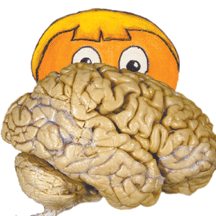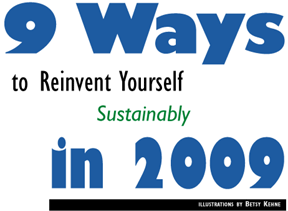
|
Volume XVII, Issue 1 - January 1 - January 7, 2009
|
|
Columns |
It’s a new year, and we hope you’ll join us in welcoming 2009.
After the shocks of 2008, this is a time to rebuild, reinventing ourselves to better withstand whatever shocks the future may bring.
With the hope of a new year fresh in our hearts, we can dream big, and build sustainably.
So to welcome 2009, we present you Nine Ways to Reinvent Yourself.
1 — Learn Something New
Your brain is a sparkling universe, as rich with could be as the universe in which Earth is one tiny spinning grain. Yet you’ve explored no more of it than, say, the route you follow, day in and day out, to work. What about all those other roads and routes? Villages, towns and cities? States and nations? Continents and oceans? Atmosphere and planets? Deep space?
If you make 2009 the year to go exploring, Chesapeake Country gives you plenty of take-off points. A new semester of classes begins in January for people of all ages, from preschoolers to senior citizens.
Browse the possibilities at colleges, arts and history centers, community and senior centers …
Colleges offer continuing education as well as degrees. Many offer greatly reduced tuition for seniors.
• ‑Anne Arundel Community College: www.aacc.edu
• ‑St. John’s College: www.sjca.edu/
• ‑College of Southern Maryland: www.csmd.edu/
• University of Maryland: www.umd.edu/
• ‑University of Maryland University College: www.umuc.edu/index.shtml
• ‑St. Mary’s College in Maryland: www.smcm.edu/
Arts and History Centers, from big centers (like Maryland Hall for the Creative Arts and Chesapeake Arts Center) to museums large and small (like Annapolis Maritime Museum, Calvert Marine Museum Captain Salem Avery House and Museum) to galleries offer classes, programs and seminars to illuminate the universe of your mind …
Senior centers offer classes, many through colleges, for small fees. Anne Arundel county has seven centers (www.aacounty.org/Aging). Calvert has three (www.marylandseniorcenters.com/Counties/Calvert.html).
Community Centers: Through county parks and recreation departments, people of all ages can explore hundreds of new ways of thinking — at very low cost and close to home. Calvert (http://www.co.cal.md.us/assets/ParksRec/2009winterbrochure.pdf) has four community centers. Anne Arundel (www.aacounty.org/RecParks/recreation_programs/index.cfm) has many, including two swim centers and one ice-staking rink.
“There’s good data on the role of mental activity in slowing aging.” Maggie O’Brien, president of St. Mary’s College, told Bay Weekly. “Whether you’re a rat or a human, routine is depressing. Learning is the other side of aging. I think we should be learning something new every day.”
–Sandra Olivetti Martin
2 — Look Your Best
— Look Your Best
Pulitzer prize-winning fashion writer Robin Givhan gets bashed every time she writes in her Washington Post column about how women look. Hillary Clinton, Cindy McCain or Sarah Palin: It doesn’t matter who they are or what side they’re on.
“We remain a culture that is quick to declare any conversation about style as shallow, any acknowledgment of a woman’s appearance as sexist and any attention to the semiotics of attire as undignified,” writes the oft-bruised Givhan.
Makes you wonder if there’s a big conspiracy of ostriches out there, all pretending that if you’ve got your head in the sand, nobody can see you.
Those ostriches are mistaken.
We may not see ourselves, but others see us. And like Givhan, they judge what they see.
Alexander Westmoreland of Alexander’s of Annapolis defines it as a root issue of self-esteem. “It’s all about giving yourself permission to do something for yourself. A lot of people can’t do that,” he says.
His cure is a simple one: “If you look good, you feel better.”
That’s why Alexander’s offers $99 makeovers, including a minifacial, and hair and make-up design. It’s priced, he says, “so people of all classes and incomes can afford a total finished look.”
Cosmetic lines at department and make-up specialty stores offer free make-up design. But if you like your new look, either way you’re likely to spend some money on creams and cosmetics.
If you’ve got sand all over your face, that may be an investment worth making.
–Sandra Olivetti Martin
3 — Improve Your Vitality
— Improve Your Vitality
Free Will Astrologist Rob Brezsny is a great advice-giver. At the end of December, he told me — and other Cancerians — that in 2009 I’d be “able to figure out how to start over in an area of life I’ve always assumed I was doomed to accept just the way it is.”
I’ve beaten him to the punch.
Bay Weekly’s first story of 2008 explored how different people had resolved to find a fit in personal fitness (www.bayweekly.com/year08/issuexvi1/leadxvi1_1.html).
I hadn’t expected to take that story so much to heart. I made no resolutions. I just happened to visit a new gym and step on an elliptical trainer. I’ve never been an athlete. But now, for the first time in my life (and I’m pretty old), I’ve discovered the pleasure of pushing way beyond where I thought I could go.
We were right in that story’s premise. Each one of us walks a different path to fitness.
From Sara Poldmae of Meadow Hill Wellness Center, here’s a principle that may help you find your path: “I think it’s about balance between activity and stillness,” the acupuncturist/wellness-entrepreneur says. In Chinese medicine, we say if you’re too still that creates stagnation. People need to be fulfilled and to work — but not too much.
“Yoga is about flexing and contracting, opening and closing, moving and stillness, so it’s an excellent way to combine both activity and stillness,” Poldmae said. “It can be very physical. I walk out sometimes really glistening with sweat.”
Meanwhile, acupuncture, massage and similar healing arts create a space for reflection, where you can gather clarity.
Such thoughts make the path to vitality sound like a place you’d want to be, with improved vitality is a bonus.
–Sandra Olivetti Martin
4  — Make Yourself a Master —
— Make Yourself a Master —
of Something
Georgetown Cupcake Factory, winner of The Washington Post’s Cupcake Wars, sells upwards of 15,000 cupcakes a year. Since last February, when sisters Sophie LaMontagne and Katherine Kallinis opened their tiny business, it’s earned them close to $2 million. The three-ounce cupcakes cost $3 and change, including taxes. A hungry man could eat one in a bite; a judicious woman could stretch one out to four bites.
Makes you want to get really good at something, doesn’t it?
Author Malcolm Gladwell coined the term outliers for such people. He thinks of outliers as “men and women who do things that are out of the ordinary.”
Do you have to be extraordinary desire or drive to do things out of the ordinary? Maybe. Gladwell’s written the book (Outliers) on the factors that influence stellar successes like Albert Einstein.
On the other hand, cupcakes are not rocket science.
I’m making it an article of faith in 2009 that you or I could succeed in the cupcake league.
Start with a bright idea.
Then, put some time into it. It might, Gladwell says, take 10,000 hours to become an expert.
Criticique, improvement and reward are the next steps. Thus Steve Kullen, Bay Weekly reader and Calvert County environmental planner, says he perfected his key lime pie by baking one a week, inviting the neighbors in to critique it and improving the next one on that basis.
He hasn’t taken his perfect pie to market; that’s a whole other plan. But he’s a key lime master.
I’m working on mastering biscotti. It’s delicious work.
It doesn’t have to be food you master, but for me food gives quick rewards.
–Sandra Olivetti Martin
5 — G et Past Conflict
et Past Conflict
Building sustainably takes more than thinking bright ideas and doing self-actualizing things. It takes girding your achievements against adversity that strikes out of the blue. For just as earthquakes, hurricanes and tsunamis assault our physical structures, so do misunderstanding, anger and rage roil us.
“Everyone has conflict,” explains Anne Arundel County Conflict Resolution Center supporter Carolyn Sullivan. “You don’t get the service you need in a store, your coworker isn’t responding on deadline, your neighbors’ dogs are peeing on your grass. Not even being Zen saves you from conflict.”
So you’ll have to get over it.
First because you’re not going to get around it. Second because, Sullivan says, “the anger provoked by conflict corrodes, physically and mentally.
“Turn that anger into doing something constructive,” Sullivan says, “and you can often solve conflict and dissipate anger.”
The Anne Arundel County Conflict Resolution Center teaches you how to make that transformation.
Anger management classes start in the new year, and mediation services by appointment help partners in conflict get beyond what’s riling them.
“We help people communicate,” Sulivan says. “They often find that what seemed like conflict is [instead] different ways of looking at things. Often in mediation, people say I didn’t know you felt like that. Or the most transformative phrase of all, I’m sorry.”
Classes charge tuition; mediation is free, though contributions are welcome. The Center is not county run; anybody can use it, without referral.
Learn to get past it at the Anne Arundel County Conflict Resolution Center: 2666 Riva Rd., Suite 130, Annapolis: 410-266-9033; www.aacrc-md.us/.
–Sandra Olivetti Martin
6 — Sustain Your Business in Hard Times
Sustain Your Business in Hard Times
Big business is in trouble across America. Talk to a small business owner — any of us across Chesapeake Country and probably across the nation — and you’ll hear their fear that the trickle-down effect could drown their hopes and wash out the achievements made over years of hard work.
Because we don’t want 2009 to be the year of that sorry fate, we’re adding the Maryland Small Business Development Center to our list of resources for reinventing yourself sustainably in the year ahead. Call up Thomas Francovitch heads the Anne Arundel center, and Maria Dorsett the Calvert center.
“We have tools and information that allow us to look into and through an existing business organization, so we can assess immediate needs and work on activities that require immediate attention,” Francovitch says.
Best of all, their help is free.
“I’m your tax dollars at work,” he says.
The statewide Maryland Small Business Development Centers are tax funded through the federal Small Business Administration and Maryland’s Department of Business and Economic Development.
For a government service, it’s surprisingly simple. It starts with a phone call. Within days, a series of personal meetings begins. They’ll meet with you and listen, person to person, to what’s on your mind. They’ll visit your office. They’ll talk you through strategies and help you work out solutions.
If you’re sensing trouble, sooner is better. “Come before you’ve used up all your resources,” Francovitch advises.
“Be careful what you ask for,” Francovitch says. “I found purpose and mission — never more than today — helping people get through what they need to get through.”
Anne Arundel Small Business Development Center: 410-222-4476; Calvert County Small Business Development Center: 410-535-4583 x 2726.
–Sandra Olivetti Martin
7  — Shrink Your Carbon Footprint
— Shrink Your Carbon Footprint
On Bay Weekly’s 15th birthday, we suggested 15 ways to shrink your carbon footprint (www.bayweekly.com/year08/
issuexvi16/leadxvi16_2.html).
Each carries the bonus of making your life choices more sustainable and helping save Chesapeake Bay. Following the path of would-be marathon runners, we chose easy ones, figuring that step by step, you’d increase your pace, distance and endurance.
Have you made any strides in walking on Earth more gently and in smaller shoes?
Have you changed to compact fluorescent bulbs or Christmas LEDs? Are you composting your biodegradables rather than grinding them down the garbage disposal or throwing them in the trash? Have you found more ways to recycle? Are you foreswearing plastic bags?
If there’s one thing 2008 has taught us, it’s that systems can collapse. Let that lesson motivate you to walk green into 2009.
–Sandra Olivetti Martin
8 —  Become a Bit of a Locavore
Become a Bit of a Locavore
The movement started four years ago with a pair of San Francisco women who challenged their neighbors: For one month, eat only food produced within a 100-mile radius of home. Within a year, communities across the country were issuing similar challenges. Eating locally became a national movement, and by 2007, the Oxford American Dictionary listed locavore as the Word of the Year.
Join the movement in 2009.
Start small. Try eggs. Chickens don’t need bikini weather to do their thing. A good number of local producers sell free-range eggs year-round.
When the ground warms up, begin to think outside the shell. By April, roadside stands and farmers’ markets welcome spring with asparagus, beets, turnips and onions. The list keeps growing month by month right up to the first freeze, a long year away.
While you’re buying freshly picked, chemical-free salad greens, chat up the farmers, ask them what they’ve got coming later in the season and what’s looking good to them. Try something new. Before long, you’ll not only be buying from a local grower, you will also be buying from a new friend. It is a win-win lifestyle.
Need another reason to go local? Consider the environmental impact. Local food is not shipped thousands of miles from field to market, thus reducing the fuel needed to get to your table. The reduced fuel consumption helps Mother Earth by decreasing harmful emissions of carbon dioxide and other greenhouse gases that pollute our environment.
By buying local, you are keeping local farms in business, preserving not only a heritage but many hundreds of acres of visually pleasing open land — a darn sight better than a new subdivision or strip mall.
Still not convinced? Then think taste. Local food is picked just before or at its peak, no earlier, so it’s at its best on your table, and it simply tastes better.
For help finding local producers from eggs on, check out www.somarylandsogood.com.
As a locavore, you needn’t forsake kitchen staples or even your favorite treats just because they aren’t produced in Maryland. Instead, think terroir, which means taste of the earth and choose foods famous for the region where they are produced, like Brie cheese from Brie, France; balsamic vinegar from Modena, Italy; coffee from the Harar region of Ethiopia, where legend places the addictive drink’s beginning. Closer to home, try Maine lobster, Gulf Coast shrimp, Minnesota wild rice.
–Margaret Tearman
9 —  Enlarge Your Universe
Enlarge Your Universe
Have you listened to Randy Pausch’s Last Lecture?
With good grace and wisdom, the dying imagineer judged how well he’d lived by the standards of how he’d achieved his own dreams and helped others live their dreams.
Have you listened to the local philanthropists interviewed in our Thanksgiving story (www.bayweekly.com/year08/issuexvi48/featuresxvi8.html)?
Still ringing in my mind are the words of Boatyard Bar and Grill owner Dick Franyo, who says he lives by the lesson taught in his first job by mentors from the Greatest Generation: “They felt to the core and preached, if you give back, you’ll have a better life.”
For those reasons, our Ninth Way is to enlarge your universe by choosing a cause that’s beyond — and bigger — than yourself. Franyo has lots of causes and gives generously to them. But the one that’s swallowed him is Annapolis’ developing National Sailing Hall of Fame, of which he’s president and working to raise $30 million. You think of a hall of fame as full of the past, but Franyo says this one is all for the present. “It’s all about kids,” he told Bay Weekly. “Using sailing to teach them math and science.”
Pausch lived his dreams — in part by enabling other people to live theirs.
How are you going to enlarge your universe in 2009?
–Sandra Olivetti Martin
